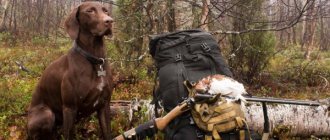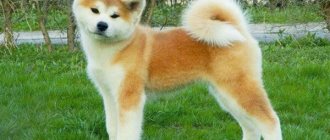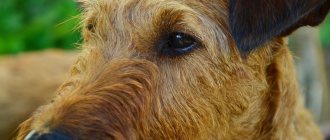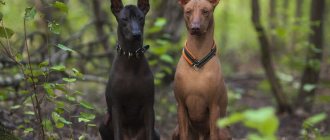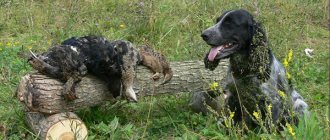Raising a dog is about developing correct behavior. This is the basis for successful training. Training is a set of activities aimed at training specific teams. It is necessary to start raising a puppy from the very first days of his appearance in the house. If you work with your pets from a very early age, then you are on the right track.
Dalmatians are active and freedom-loving dogs with an athletic build. They are very energetic and active. Dogs are ideal for active and athletic people.
- Country of origin : Croatia
- Height at withers : male: 56-62 cm; female: 54-50 cm
- Weight : male: 40-45 kg; female: 32-35 kg
- Lifespan : 10-13 years
- Use : Companion Dog
When to start training a dog
As soon as a Dalmatian puppy appears in your home, immediately begin to build a relationship with him. From the first day it is necessary to provide him with everything he needs: bowls for water and food, collar, leash, bed, suitable food, toys and of course treats. You need to give him a lot of attention so that he feels safe and begins to trust you. From a very early age, the Dalmatian puppy must be introduced to commands. In addition, in the first months it is necessary to study commands both at home and on the street. First, the puppy must remember its name. We wrote how to choose a suitable nickname in one of our articles. The name should be short, easy to remember and the dog should be called only by it. When the pet has already mastered its name and finally begins to respond, then we move on to commands. By the 3rd month he should master the following commands: “Ugh!”, “Come to me!”, “Place!”, “Nearby!” and “Fetch!” (optional). Then you can move on to the rest, of course, if you need them.
Interesting Facts
- Dalmatians served in the English fire brigade. They ran in front of the horse-drawn carriage and barked loudly, scaring passers-by. Dalmatians actually served as special signals that are installed on modern fire trucks.
- The dark spots on the Dalmatian's body range in size from 3 to 6 centimeters.
- Dogs love to lick their owner's face. Thus, they express their joy and gratitude.
- One litter can have Dalmatians with three different colors (brown, black, white).
- Fans of the breed are Salma Hayek, Monica Bellucci, Robert De Niro and other famous actors.
- According to ancient Indian legend, the Dalmatian was the result of a meeting between a Bengal tiger and a dog.
- A Dalmatian can run tens of kilometers without stopping.
- Many people think that spotted wool is the result of selective breeding. This is wrong. Dalmatians are given dark spots by nature.
How to raise a Dalmatian puppy
If you train your pet correctly, then over time you will get an obedient dog that will follow all commands and delight you every day. Experts believe that several factors may influence the Dalmatian’s susceptibility to following various commands:
- pet's temperament - the speed of the pet's reaction to stimuli, both positive and negative;
- character - how exactly the dog resists various unpleasant influences;
- obedience - the dog’s ability to accept human leadership;
- vigilance - the speed with which the dog notices potential danger, both in relation to itself and in relation to the owner;
- aggressiveness - the pet’s ability to react hostilely to potential danger;
- curiosity - interest that is developed when a dog feels, hears and sees something;
- sociability - the ability to interact with people;
- possessiveness is the interest shown by animals in certain objects, for example toys.
How quickly your dog will learn commands depends on which traits predominate in the character of a Dalmatian puppy. By paying attention to the character traits of your animal, you can find an approach to it and adjust its behavior in certain situations.
- Eagerness will get you nowhere . You should not try to teach your Dalmatian puppy all the commands at the same time; you need to learn the commands one by one. You need to have patience and act methodically. You should not scold your pet at the moment when he makes mistakes, and when he succeeds in something, then the pet should be encouraged.
- Don't hit . It is prohibited to use physical punishment against a pet. You should limit yourself to variable intonation, but avoid shouting. After the Dalmatian puppy is three months old, it is allowed to use a light spank as punishment while saying the phrase “Ew.” It is necessary to punish immediately when the animal commits an offense, and not after it, since the animal simply will not understand what exactly it was punished for.
- Subsequence . The main goal is to ensure that the pet follows the command the first time. Commands should be pronounced clearly and in an even voice so that the dog understands and obeys you. All family members should be involved in raising the dog, but they must act together. It is forbidden to allow situations in which you scold the puppy, and another family member praises him or simply does not pay attention.
- Pamper . Remember to reward your Dalmatian puppy with a variety of treats and praise when he has done what is asked of him.
Character
The Dalmatian is a sociable animal with a high level of intelligence and a stable nervous system. The dog is characterized by some stubbornness and independence. Dalmatians become very attached to their owners and require constant attention from them. The animal is quick-witted, has excellent memory and has a good sense of a person’s emotional mood.
If the Dalmatian sees that the owner is in a bad mood, then he will try in every possible way to cheer him up. The dog does not show aggression towards strangers, so it cannot be used as a guard. Dalmatians are involved in the process of canistherapy. Dogs relieve people of moral and physical suffering. Animals also work as guides and help find missing items.
Basic commands
You will use some commands more often, others less often. But they will still come in handy to easily interact with your Dalmatian and even keep him safe in various situations.
- Aport. One of the most difficult teams. Many people perceive it as very easy and simple, but with many dogs you will have to work hard. This skill is used for other exercises: searching, searching, selecting an item and many others. Usually they are all used in service. When working out a command, “Aport” and “Give” are used, and a gesture is also used.
- Give. On the command “Give” the dog must give up the object.
- Lie. A connecting command that needs to be learned for other commands. In addition, it will not interfere at home or on the street.
- To me. You will need to use this command quite often. So start with it immediately after your Dalmatian puppy has learned his name. Never call the dog to punish, and do not scold if it comes on its own, even after mischievousness before it. This behavior on your part may alienate the animal.
- Place. A puppy or an adult dog must clearly know where his place is located. He can sleep anywhere, if you allow it, of course, but he must know this command. You can use it outside the home, marking the place with a leash or your favorite toy.
- Near. It is possible to teach your pet the “Near” command at any age, be it an adult dog or a small puppy. When you move to a new home, you should immediately think about training your puppy.
- Sit. One of the very first commands that a Dalmatian puppy should learn.
- Stand. The command is useful in everyday life, for example, for combing a dog.
- . The prohibiting command is one of the most mandatory and taming it begins from the first day the puppy appears in the house. Requiring the command “Fu!”, “No!”, “No!” - immediately stop the unwanted action.
Features of caring for Dalmatians
Dalmatians can be kept both in a city apartment and in a private house. But under no circumstances should he be on a chain or in an enclosure. In frosty weather, it is better for the dog to wear overalls.
As for walks, in the case of Dalmatians they should last at least 1.5 hours several times a day. The dog must undergo active physical activity. Swimming is especially beneficial for this breed of dog. It helps develop the breasts by strengthening the muscles.
The short coat of Dalmatians sheds a lot. Therefore, dogs are advised to brush frequently. But you need to bathe them only when their fur gets dirty.
A healthy Dalmatian diet should consist of poultry, lean meat, vegetables, cottage cheese, fish oil, and vitamins. This breed has one characteristic of the body, namely the formation of uric acid in the blood. And this is fraught with urolithiasis. You need to be very careful with protein intake. If it is in excess, then a diet is recommended - 5% meat, 10% vegetables, 80% rice and plenty of liquid. It is worth remembering that dry food can cause allergies in Dalmatians.
Raising a dog
Education is the process of shaping Dalmatian behavior acceptable to the owner, when this behavior is not regulated by commands.
During upbringing, a dog develops relationships with its owner, family members, passers-by, behavior in the house, on the street, and relationships with other dogs. The training process begins immediately when the dog first appears in the house and continues throughout the dog’s life. Regardless of the dog's breed, it must be trained. Just as people do not like ill-mannered people, dogs should also know what is allowed and what is not allowed. Raising a dog is a rather complex process, which is not limited to learning just a few commands. The main goal of education is that the dog should become pleasant to talk to. In addition, it must be manageable at some points, otherwise it will be very difficult for the dog owner. In the broadest sense of the word, dog training is about teaching the dog commands such as “Bad” and “No”. But besides this, the dog must know what is good and what is bad, even in those moments when the owner is not around. Some believe that the Dalmatian only understands commands, but cannot generalize. Only those who, as a rule, never had dogs, and studied them only in laboratory conditions, in which dogs were not able to show their full potential, are convinced of this, as well as those who, due to their personal qualities, were unable to establish a relationship with pet. In real life, the Dalmatian is a pack animal and therefore, like any other pack animal, needs to communicate with members of its family. In this situation, the dog’s family members are people. It is quite stupid to think that if a dog caresses you, this means that his skin is itching. In order for a dog’s nervous system to function normally, it needs affection, love, communication, and praise. In addition, so-called “inhibiting factors” are required, because if the dog is allowed everything, then this will not lead to anything good. When raising a Dalmatian puppy, you should pay attention to the genetic characteristics of the breed. A family is a pack in which there must be a leader, in this case the leader is a person. The leader punishes, plays, feeds, caresses, praises and scolds. All other members of the owner's family are ranked by rank. At that moment, while the puppy is small, all other family members are senior to him. However, in the process of growing up, around the age of one year, the dog begins to look for its place in the hierarchical pyramid. Naturally, she will try to take the step that is as high as possible. She can do this with the help of force, in the case of large dogs, or with the help of cunning, as small dogs do. The more ill-mannered the dog is, the more difficult this process will be. If the owner from the first days shows his pet that the one who has the power is right, then he will turn out to be a frail neurotic or an evil beast with whom you will hardly communicate with joy. A Dalmatian puppy must understand that he must obey people, since they love him, feed him, and raise him. Understand that prohibitions are not the whim of the owner, but a way to protect everyone from trouble. The main influence on the dog should be the voice. From the first days of being in your home, the puppy must realize that you love him, and if you raise your voice, then this means that he is doing something wrong. One of the best incentives for a pet is considered to be a treat, which should be given out for good behavior and listening to commands. Training and education of a Dalmatian
Story
The age of the rock is several thousand years. Cynologists have not come to a consensus about which country is the homeland of Dalmatians. One version says that Dalmatians appeared in India. Then the dogs came to Italy, and a little later they were brought to Dalmatia (one of the regions of Croatia).
Dalmatians accompanied carriages with noble people. The dogs walked ahead of the horses and protected the carriage passengers from attacks by robbers and predatory animals. England is considered the second homeland of Dalmatians. It was in this country that the first description of the breed appeared in 1890. The international breed standard was approved in 1926 in Monaco.
Health
The most vulnerable areas of these dogs are the kidneys and skin.
They are prone to ureteral stones. If your pet does not allow you to pet him in the lower back area, you should be wary, this may indicate health problems. Kidney problems can occur even in small puppies. Hence the problems with the skin, for example, a bronze color appears when there is kidney disease. Allergic reactions may also occur. Also, dogs of this breed may have gastric torsion, are prone to dysplasia, eye diseases, and deafness. Twelve percent of Dalmatian puppies are already born with deafness, so the condition needs to be detected early.
How many years do Dalmatians live? On average, with proper care, the life expectancy of these dogs is ten to twelve years. How long Dalmatians live depends directly on the conditions of their detention, active exercise and nutrition, and the psychological atmosphere in the family.
Elimination of omissions and unclear situations
A small dog should not be treated roughly. Kindness and patience are the correct behavior of the owner. The solution will bring success in the relationship between man and animal. The puppy has the right not always and not immediately to understand the wishes of the owner, what kind of behavior people expect. If a baby tries to lick an older friend, it means he is asking and wants to make up for the misunderstanding with affectionate behavior.
If the dog reacts correctly to a person’s demands, it is recommended to reward the pet: give a tidbit or stroke it, praise it with words in a soft voice. Dalmatians are sensitive animals, they try to please the “leader” and make them happy.
Prices
How much does a Dalmatian cost? Inexpensive. Anyone can afford it if they consider themselves responsible and capable of keeping an active dog.
The cost of puppies depends on the nursery where you decide to purchase and the class of the puppy.
- If your choice fell on a pet-class puppy, which will become an excellent companion, but will have deviations from the standard, then you will pay from 5 to 8 thousand rubles for it.
- For representatives of the breed class, who can participate in exhibitions and receive good marks, nurseries ask from 9 to 15 thousand rubles.
- Elite puppies - future winners of exhibitions and competitions - cost from about 15-20 thousand rubles and more.
My home is my castle
From the first minutes of the little Dalmatian's appearance in the house, show your pet a corner. It is recommended to prepare a comfortable place that gives the dog a feeling of safety and comfort.
When accustoming the puppy to a place, take or take the dog there. Then try to place him on a soft bedding, stroke him and treat him with a treat, reminding him in a friendly manner: “Place.” They do this until the puppy understands that it is good here. Then the baby will begin to find a home after playing on his own. If you want to send your baby to a place on command, it is necessary to ensure that the dog understands that it is pleasant there, that something tasty awaits the dog.
Place training may take some time, but the desire to raise the puppy correctly will give strength to patience in training. Every correct action is rewarded! By repeating: “Okay!”, a person reinforces a behavioral stereotype in the dog’s mind.


